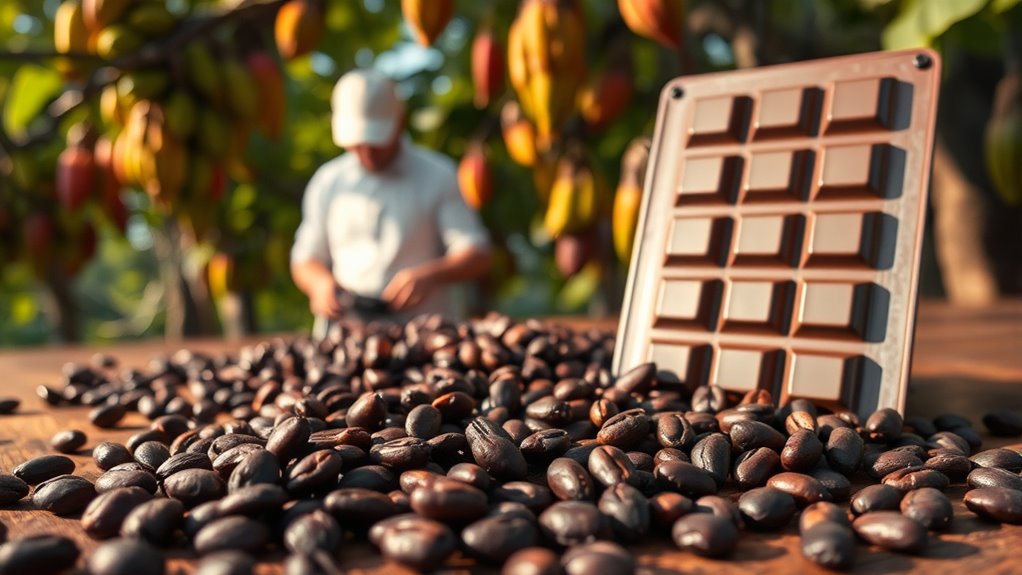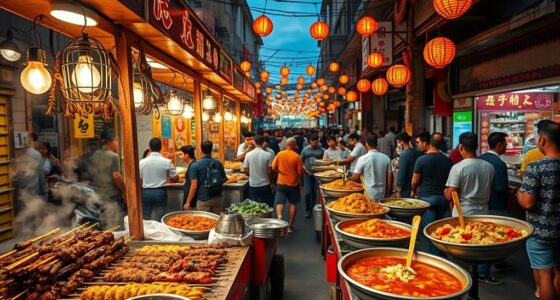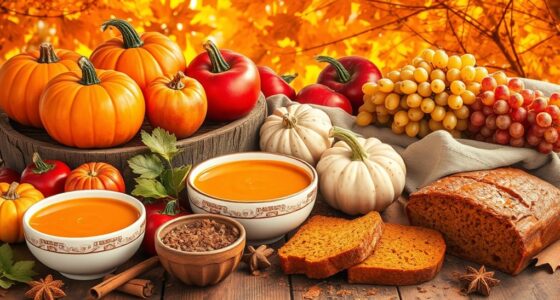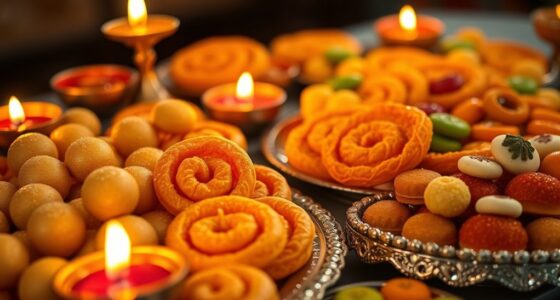Beginning on a bean-to-bar tour, you’ll see how cacao beans are cultivated on tropical farms before being harvested and fermented. You’ll observe roasting and grinding processes that develop flavor, then enjoy conching and tempering to craft smooth chocolate. These tours highlight centuries of tradition, craftsmanship, and innovation behind your favorite treat. If you want to uncover the full journey from pod to perfect bar, there’s plenty more to explore along the way.
Key Takeaways
- Tours showcase the entire process from harvesting cocoa pods to fermenting beans, highlighting traditional and modern techniques.
- Visitors learn about cacao cultivation, harvesting, and fermentation, emphasizing sustainable farming practices.
- The journey includes roasting, winnowing, grinding, and conching, demonstrating how raw beans transform into chocolate.
- Many tours connect visitors to the cultural history and craftsmanship behind chocolate-making.
- Tasting sessions often feature fresh cacao, raw ingredients, and finished chocolate, enriching appreciation for the product’s origin.
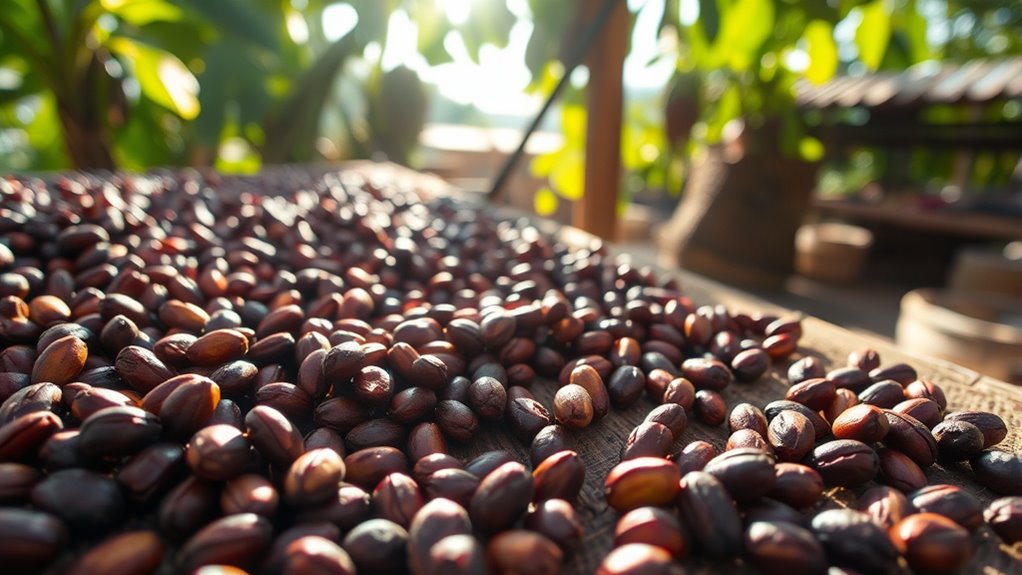
Have you ever wondered where chocolate comes from? The journey begins in cocoa farms, where skilled farmers cultivate the cocoa trees that produce the beans essential for your favorite treat. These farms, often nestled in tropical regions like West Africa, Central and South America, and Southeast Asia, are the starting point of chocolate’s long history. Cocoa farming isn’t just about planting trees; it’s about understanding the delicate balance of nature, climate, and farming techniques that affect the quality of the beans. Farmers carefully harvest ripe pods, extract the beans, and ferment them to develop the rich flavors that will eventually become chocolate. This process has been refined over centuries, influenced by a fascinating chocolate history that dates back thousands of years. Understanding the impact of climate control on cocoa cultivation helps ensure high-quality harvests and sustainable farming practices. Ancient civilizations, like the Mayans and Aztecs, first discovered cacao’s potential, turning it into a bitter beverage used in rituals and as currency. When Europeans encountered cacao, they added sugar and spices, revolutionizing chocolate into the sweet, creamy delight we know today. This transformation reflects a rich chocolate history that spans cultures and centuries, shaping the way we perceive and enjoy this beloved food. As you explore the story of chocolate, you’ll see how each step, from cocoa farming to the final product, is rooted in tradition and innovation. When you visit a chocolate factory or participate in a bean-to-bar tour, you witness firsthand how cacao beans are transformed. The journey from bean to bar involves roasting, winnowing, grinding, and conching—each step crucial to developing the complex flavors and textures. The roasting process, for instance, unblocks the fragrant compounds that define chocolate’s aroma, while conching smooths the mixture into a silky consistency. Every stage requires precision and expertise, often passed down through generations, contributing to the ongoing chocolate history. Understanding cocoa farming helps you appreciate the effort behind each bite. It’s not just about the end product but the entire story of cultivation, harvest, fermentation, and processing. This journey connects you directly to the farmers and the centuries of tradition that influence every bar you enjoy. From the lush cacao plantations to the bustling chocolate factories, the path from bean to bar is a testament to centuries of craftsmanship, innovation, and cultural exchange. So, next time you savor a piece of chocolate, remember the complex history and dedicated farming that made it possible, and appreciate the rich story behind every bite.
Frequently Asked Questions
What Are the Health Benefits of Dark Chocolate?
You’ll enjoy health benefits from dark chocolate, thanks to its high cocoa content. During cocoa cultivation and chocolate processing, antioxidants called flavonoids are preserved, which can boost your heart health, improve circulation, and reduce inflammation. Dark chocolate also contains minerals like magnesium and iron. Just remember to indulge in moderation, as it’s calorie-dense. By choosing high-quality dark chocolate, you get the most health perks from your treat.
How Do Different Cocoa Varieties Affect Flavor?
Ever wonder why chocolate tastes so different? It all comes down to cocoa flavor profiles, which vary with bean variety influence. Different cocoa varieties bring unique notes—some are fruity and bright, others earthy or nutty. As you explore, you’ll discover that each bean’s origin shapes the flavor, creating a rich tapestry of tastes. So, next time you indulge, remember, the variety of cocoa beans is what makes each chocolate experience special.
What Sustainable Practices Are Used in Chocolate Farming?
You can support sustainable chocolate farming by looking for practices like cocoa fermentation, which enhances flavor while maintaining the environment. Farmers often use sustainable packaging to reduce waste and minimize ecological impact. These methods help conserve resources, protect biodiversity, and promote fair labor practices. By choosing chocolates that emphasize sustainable practices, you contribute to a healthier planet and ensure future cocoa production remains eco-friendly and socially responsible.
How Is Fair Trade Certification Determined?
Fair trade certification is like a lighthouse guiding ethical practices. It’s determined by certification standards set by organizations that verify farmers meet strict social, economic, and environmental criteria. You can trust that products with this label guarantee fair wages, safe working conditions, and sustainable farming methods. When you see the certification, it means the producer has adhered to these standards, promoting fairness and sustainability throughout the supply chain.
Can Chocolate Be Made Vegan and Still Taste Rich?
Yes, you can make chocolate vegan and still enjoy a rich flavor. By using vegan sweeteners like coconut sugar or agave syrup, and incorporating plant-based milk options such as almond or oat milk, the chocolate maintains its creamy, indulgent texture. These choices enhance the flavor profile while keeping it cruelty-free. So, vegan chocolates can be just as luscious and satisfying as traditional ones, perfect for any chocolate lover.
Conclusion
As you finish your chocolate journey, remember that each bar is like a tiny treasure chest, holding stories from distant lands. From the vibrant farms to the skilled artisans, every step is a crucial part of its story. When you take a bite, imagine the rich history and effort behind it, much like a tapestry woven with passion and tradition. Savor each piece, knowing you’re tasting more than just chocolate—you’re experiencing a world of craftsmanship.
